Ecological Function Zoning Framework for Small Watershed Ecosystem Services Based on Multivariate Analysis from a Scale Perspective
Abstract
:1. Introduction
2. Materials and Methods
2.1. Study Area
2.2. Research Framework
2.2.1. ES Selection
2.2.2. Influencing Factors
2.2.3. Scale Analysis
2.3. Methods
2.3.1. InVEST Model
2.3.2. Geographical Detector (GD)
2.4. Statistical Analysis
2.4.1. Redundancy Analysis
2.4.2. Pearson Correlation Analysis (PCA)
2.4.3. Services Hotspots
2.5. Data Sources
3. Results
3.1. Spatio-Temporal Changes of ESs
3.2. Influencing Factors on ESs
3.2.1. Relationships between Influencing Factors and All ESs
3.2.2. Individual ES Drivers in Spatial Heterogeneity
3.3. Interactions among ESs at Various Spatial Scales
3.4. Identification of ES Hotspots at Each Spatial Scale
3.5. Results of Ecological Zoning in ARB
4. Discussion
4.1. Changes in ESs by Land Use Pattern
4.2. Relationships between ESs
4.3. Influencing Factors Analysis
4.4. Sustainable Development Strategy of ESs in Small Basins
5. Conclusions
Supplementary Materials
Author Contributions
Funding
Data Availability Statement
Conflicts of Interest
References
- Millennium Ecosystem Assessment. Ecosystems and Human Well-Being: Synthesis; Island Press: Washington, DC, USA, 2005. [Google Scholar]
- Groot, R.S.d.; Wilson, M.A.; Boumans, R.M.J. A typology for the classification, description and valuation of ecosystem functions, goods and services. Ecol. Econ. 2002, 41, 393–408. [Google Scholar]
- Redhead, J.W.; Stratford, C.; Sharps, K.; Jones, L.; Ziv, G.; Clarke, D.; Oliver, T.H.; Bullock, J.M. Empirical validation of the InVEST water yield ecosystem service model at a national scale. Sci. Total Environ. 2016, 569–570, 1418–1426. [Google Scholar] [PubMed]
- Malinga, R.; Gordon, L.J.; Jewitt, G.; Lindborg, R. Mapping ecosystem services across scales and continents—A review. Ecosyst. Serv. 2015, 13, 57–63. [Google Scholar]
- Li, R.; Shi, Y.; Feng, C.C.; Guo, L. The spatial relationship between ecosystem service scarcity value and urbanization from the perspective of heterogeneity in typical arid and semiarid regions of China. Ecol. Indic. 2021, 132, 108299. [Google Scholar]
- Hou, Y.; Li, B.; Muller, F.; Fu, Q.; Chen, W. A conservation decision-making framework based on ecosystem service hotspot and interaction analyses on multiple scales. Sci. Total Environ. 2018, 643, 277–291. [Google Scholar]
- Blumstein, M.; Thompson, J.R.; Nally, R.M. Land-use impacts on the quantity and configuration of ecosystem service provisioning in Massachusetts, USA. J. Appl. Ecol. 2015, 52, 1009–1019. [Google Scholar]
- Costanza, R.; de Groot, R.; Braat, L.; Kubiszewski, I.; Fioramonti, L.; Sutton, P.; Farber, S.; Grasso, M. Twenty years of ecosystem services: How far have we come and how far do we still need to go? Ecosyst. Serv. 2017, 28, 1–16. [Google Scholar]
- Leh, M.D.K.; Matlock, M.D.; Cummings, E.C.; Nalley, L.L. Quantifying and mapping multiple ecosystem services change in West Africa. Agric. Ecosyst. Environ. 2013, 165, 6–18. [Google Scholar]
- Li, G.; Fang, C.; Wang, S. Exploring spatiotemporal changes in ecosystem-service values and hotspots in China. Sci. Total Environ. 2016, 545–546, 609–620. [Google Scholar] [CrossRef]
- Bukvareva, E.; Zamolodchikov, D.; Kraev, G.; Grunewald, K.; Narykov, A. Supplied, demanded and consumed ecosystem services: Prospects for national assessment in Russia. Ecol. Indic. 2017, 78, 351–360. [Google Scholar] [CrossRef]
- Bai, Y.; Ouyang, Z.; Zheng, H.; Li, X.; Zhuang, C.; Jiang, B. Modeling soil conservation, water conservation and their tradeoffs: A case study in Beijing. J. Environ. Sci. 2012, 24, 419–426. [Google Scholar] [CrossRef] [PubMed]
- Su, S.; Li, D.; Hu, Y.; Xiao, R.; Zhang, Y. Spatially non-stationary response of ecosystem service value changes to urbanization in Shanghai, China. Ecol. Indic. 2014, 45, 332–339. [Google Scholar] [CrossRef]
- Lu, X.; Shi, Y.; Chen, C.; Yu, M. Monitoring cropland transition and its impact on ecosystem services value in developed regions of China: A case study of Jiangsu Province. Land Use Policy 2017, 69, 25–40. [Google Scholar] [CrossRef]
- Dou, H.; Li, X.; Li, S.; Dang, D.; Li, X.; Lyu, X.; Li, M.; Liu, S. Mapping ecosystem services bundles for analyzing spatial trade-offs in inner Mongolia, China. J. Clean. Prod. 2020, 256, 120444. [Google Scholar] [CrossRef]
- Zhao, M.; He, Z.; Du, J.; Chen, L.; Lin, P.; Fang, S. Assessing the effects of ecological engineering on carbon storage by linking the CA-Markov and InVEST models. Ecol. Indic. 2019, 98, 29–38. [Google Scholar] [CrossRef]
- Zhang, Z.M.; Gao, J.F.; Fan, X.Y.; Lan, Y.; Zhao, M.S. Response of ecosystem services to socioeconomic development in the Yangtze River Basin, China. Ecol. Indic. 2017, 72, 481–493. [Google Scholar] [CrossRef]
- Qi, X.; Wang, K.L.; Zhang, C.H. Effectiveness of ecological restoration projects in a karst region of southwest China assessed using vegetation succession mapping. Ecol. Eng. 2013, 54, 245–253. [Google Scholar] [CrossRef]
- Feng, Q.; Zhao, W.; Fu, B.; Ding, J.; Wang, S. Ecosystem service trade-offs and their influencing factors: A case study in the Loess Plateau of China. Sci. Total Environ. 2017, 607–608, 1250–1263. [Google Scholar] [CrossRef] [PubMed]
- Mao, D.; He, X.; Wang, Z.; Tian, Y.; Xiang, H.; Yu, H.; Man, W.; Jia, M.; Ren, C.; Zheng, H. Diverse policies leading to contrasting impacts on land cover and ecosystem services in Northeast China. J. Clean. Prod. 2019, 240, 117961. [Google Scholar] [CrossRef]
- Pan, Y.; Xu, Z.R.; Wu, J.X. Spatial differences of the supply of multiple ecosystem services and the environmental and land use factors affecting them. Ecosyst. Serv. 2013, 5, E4–E10. [Google Scholar] [CrossRef]
- Jing, H.A.; Liu, Y.H.; He, P.; Zhang, J.Q.; Dong, J.Y.; Wang, Y. Spatial heterogeneity of ecosystem services and it’s influencing factors in typical areas of the Qinghai-Tibet Plateau: A case of Nagqu City. Acta Ecol. Sin. 2021, 42, 2657–2673. (In Chinese) [Google Scholar]
- Li, J. Identification of ecosystem services supply and demand and driving factors in Taihu Lake Basin. Environ. Sci. Pollut. Res. 2022, 29, 29735–29745. [Google Scholar] [CrossRef] [PubMed]
- Li, J.; Zhou, Z.X. Natural and human impacts on ecosystem services in Guanzhong—Tianshui economic region of China. Environ. Sci. Pollut. Res. 2016, 23, 6803–6815. [Google Scholar] [CrossRef] [PubMed]
- Cumming, G.S.; Buerkert, A.; Hoffmann, E.M.; Schlecht, E.; von Cramon-Taubadel, S.; Tscharntke, T. Implications of agricultural transitions and urbanization for ecosystem services. Nature 2014, 515, 50–57. [Google Scholar] [CrossRef] [PubMed]
- Li, Z.; Xia, J.; Deng, X.Z.; Yan, H.M. Multilevel modelling of impacts of human and natural factors on ecosystem services change in an oasis, Northwest China. Resour. Conserv. Recycl. 2021, 169, 105474. [Google Scholar] [CrossRef]
- Su, C.; Fu, B. Evolution of ecosystem services in the Chinese Loess Plateau under climatic and land use changes. Glob. Planet. Change 2013, 101, 119–128. [Google Scholar] [CrossRef]
- Bai, Y.; Ochuodho, T.O.; Yang, J. Impact of land use and climate change on water-related ecosystem services in Kentucky, USA. Ecol. Indic. 2019, 102, 51–64. [Google Scholar] [CrossRef]
- Liu, Z.T.; Wu, R.; Chen, Y.X.; Fang, C.L.; Wang, S.J. Factors of ecosystem service values in a fast-developing region in China: Insights from the joint impacts of human activities and natural conditions. J. Clean. Prod. 2021, 297, 126588. [Google Scholar] [CrossRef]
- Luo, Q.; Zhou, J.; Li, Z.; Yu, B. Spatial differences of ecosystem services and their driving factors: A comparation analysis among three urban agglomerations in China’s Yangtze River Economic Belt. Sci. Total Environ. 2020, 725, 138452. [Google Scholar] [CrossRef]
- Sun, X.; Shan, R.; Liu, F. Spatio-temporal quantification of patterns, trade-offs and synergies among multiple hydrological ecosystem services in different topographic basins. J. Clean. Prod. 2020, 268, 122338. [Google Scholar] [CrossRef]
- Zhang, Z.Y.; Liu, Y.F.; Wang, Y.H.; Liu, Y.L.; Zhang, Y.; Zhang, Y. What factors affect the synergy and tradeoff between ecosystem services, and how, from a geospatial perspective? J. Clean. Prod. 2020, 257, 120454. [Google Scholar] [CrossRef]
- Zhang, C.; Li, J.; Zhou, Z.; Sun, Y. Application of ecosystem service flows model in water security assessment: A case study in Weihe River Basin, China. Ecol. Indic. 2021, 120, 106974. [Google Scholar] [CrossRef]
- Pan, N.H.; Guan, Q.Y.; Wang, Q.Z.; Sun, Y.F.; Li, H.C.; Ma, Y.R. Spatial Differentiation and Driving Mechanisms in Ecosystem Service Value of Arid Region: A case study in the middle and lower reaches of Shule River Basin, NW China. J. Clean. Prod. 2021, 319, 128718. [Google Scholar] [CrossRef]
- Xiao, Q.; Hu, D.; Xiao, Y. Assessing changes in soil conservation ecosystem services and causal factors in the Three Gorges Reservoir region of China. J. Clean. Prod. 2017, 163, S172–S180. [Google Scholar] [CrossRef]
- Bennett, E.M.; Peterson, G.D.; Gordon, L.J. Understanding relationships among ecosystem services. Ecol. Lett. 2009, 12, 054020. [Google Scholar] [CrossRef] [PubMed]
- Liu, X.; Burrascharles, L.; Kravchenkoyuri, S. Overview of Mollisols in the world: Distribution, land use and management. Can. J. Soil Sci. 2012, 92, 383–402. [Google Scholar] [CrossRef]
- Fang, Z.; Bai, Y.; Jiang, B.; Alatalo, J.M.; Liu, G.; Wang, H. Quantifying variations in ecosystem services in altitude-associated vegetation types in a tropical region of China. Sci. Total Environ. 2020, 726, 138565. [Google Scholar] [CrossRef] [PubMed]
- Daw, T.; Brown, K.; Rosendo, S.; Pomeroy, R. Applying the ecosystem services concept to poverty alleviation: The need to disaggregate human well-being. Environ. Conserv. 2011, 38, 370–379. [Google Scholar] [CrossRef]
- Lyu, R.; Clarke, K.C.; Zhang, J.; Feng, J.; Jia, X.; Li, J. Spatial correlations among ecosystem services and their socio-ecological driving factors: A case study in the city belt along the Yellow River in Ningxia, China. Appl. Geogr. 2019, 108, 64–73. [Google Scholar] [CrossRef]
- Pan, J.; Wei, S.; Li, Z. Spatiotemporal pattern of trade-offs and synergistic relationships among multiple ecosystem services in an arid inland river basin in NW China. Ecol. Indic. 2020, 114, 106345. [Google Scholar] [CrossRef]
- Yang, S.L.; Bai, Y.; Alatalo, J.M.; Wang, H.M.; Jiang, B.; Liu, G.; Chen, J.Y. Spatio-temporal changes in water-related ecosystem services provision and trade-offs with food production. J. Clean. Prod. 2021, 286, 125316. [Google Scholar] [CrossRef]
- Chen, T.; Feng, Z.; Zhao, H.; Wu, K. Identification of ecosystem service bundles and driving factors in Beijing and its surrounding areas. Sci. Total Environ. 2020, 711, 134687. [Google Scholar] [CrossRef] [PubMed]
- Deng, C.; Zhu, D.; Nie, X.; Liu, C.; Zhang, G.; Liu, Y.; Li, Z.; Wang, S.; Ma, Y. Precipitation and urban expansion caused jointly the spatiotemporal dislocation between supply and demand of water provision service. J. Environ. Manag. 2021, 299, 113660. [Google Scholar] [CrossRef] [PubMed]
- Wang, L.; Zheng, H.; Wen, Z.; Liu, L.; Robinson, B.E.; Li, R.N.; Li, C.; Kong, L.Q. Ecosystem service synergies/trade-offs informing the supply-demand match of ecosystem services: Framework and application. Ecosyst. Serv. 2019, 37, 100939. [Google Scholar] [CrossRef]
- Raudsepp-Hearne, C.; Peterson, G.D.; Bennett, E.M. Ecosystem service bundles for analyzing tradeoffs in diverse landscapes. PNAS 2010, 107, 5242–5247. [Google Scholar] [CrossRef] [PubMed]
- Cornelius, J.; Juergen, K.; Joachim, M.; Thomas, K. Interactions among ecosystem services across Europe: Bagplots and cumulative correlation coefficients reveal synergies, trade-offs, and regional patterns. Ecol. Indic. 2014, 49, 46–52. [Google Scholar] [CrossRef]
- Wang, J.; Zhou, W.; Pickett, S.T.A.; Yu, W.; Li, W. A multiscale analysis of urbanization effects on ecosystem services supply in an urban megaregion. Sci. Total Environ. 2019, 662, 824–833. [Google Scholar] [CrossRef] [PubMed]
- Li, T.; Lv, Y.; Fu, B.; Hu, W.; Comber, A.J. Bundling ecosystem services for detecting their interactions driven by large-scale vegetation restoration: Enhanced services while depressed synergies. Ecol. Indic. 2019, 99, 332–342. [Google Scholar] [CrossRef]
- Li, H.; Mao, D.; Li, X.; Wang, Z.; Jia, M.; Huang, X.; Xiao, Y.; Xiang, H. Understanding the contrasting effects of policy-driven ecosystem conservation projects in northeastern China. Ecol. Indic. 2022, 135, 108578. [Google Scholar] [CrossRef]
- Pan, Z.; Wang, J. Spatially heterogeneity response of ecosystem services supply and demand to urbanization in China. Ecol. Eng. 2021, 169, 106303. [Google Scholar] [CrossRef]
- Wang, H.; Wang, W.J.; Liu, Z.; Wang, L.; Zhang, W.; Zou, Y.; Jiang, M. Combined effects of multi-land use decisions and climate change on water-related ecosystem services in Northeast China. J. Environ. Manag. 2022, 315, 115131. [Google Scholar] [CrossRef] [PubMed]
- Xiang, H.; Zhang, J.; Mao, D.; Wang, Z.; Qiu, Z.; Yan, H. Identifying spatial similarities and mismatches between supply and demand of ecosystem services for sustainable Northeast China. Ecol. Indic. 2022, 134, 108501. [Google Scholar] [CrossRef]
- Zhang, X.; Dong, L.; Huang, Y.; Xu, Y.; Qin, H.; Qiao, Z. Equilibrium Relationship between Ecosystem Service Supply and Consumption Driven by Economic Development and Ecological Restoration. Sustainability 2021, 13, 1486. [Google Scholar] [CrossRef]
- Li, X.; Huang, C.; Jin, H.; Han, Y.; Kang, S.; Liu, J.; Cai, H.; Hu, T.; Yang, G.; Yu, H.; et al. Spatio-Temporal Patterns of Carbon Storage Derived Using the InVEST Model in Heilongjiang Province, Northeast China. Front. Earth Sci. 2022, 10, 846456. [Google Scholar] [CrossRef]
- Ning, J.; Shi, D.; Zhou, S.; Xia, Z. Spatial and temporal patterns of ecosystem services and trade-off synergistic relationships in Bin County, Heilongjiang Province. Res. Soil Water Conserv. 2022, 29, 293–300. (In Chinese) [Google Scholar] [CrossRef]
- Gan, S.; Xiao, Y.; Qin, K.; Liu, J.; Xu, J.; Wang, Y.; Niu, Y.; Huang, M.; Xie, G. Analyzing the Interrelationships among Various Ecosystem Services from the Perspective of Ecosystem Service Bundles in Shenyang, China. Land 2022, 11, 515. [Google Scholar] [CrossRef]
- Wang, H.; Wang, W.; Wang, L.; Ma, S.; Liu, Z.; Zhang, W.; Zou, Y.; Jiang, M. Impacts of Future Climate and Land Use/Cover Changes on Water-Related Ecosystem Services in Changbai Mountains, Northeast China. Front. Ecol. Evol. 2022, 10, 854497. [Google Scholar] [CrossRef]
- Hou, Y.; Lv, Y.; Chen, W.; Fu, B. Temporal variation and spatial scale dependency of ecosystem service interactions: A case study on the central Loess Plateau of China. Landsc. Ecol. 2017, 32, 1201–1217. [Google Scholar] [CrossRef]
- Cui, F.; Tang, H.; Zhang, Q.; Wang, B.; Dai, L. Integrating ecosystem services supply and demand into optimized management at different scales: A case study in Hulunbuir, China. Ecosyst. Serv. 2019, 39, 100984. [Google Scholar] [CrossRef]
- Li, J.; Bai, Y.; Alatalo, J.M. Impacts of rural tourism-driven land use change on ecosystems services provision in Erhai Lake Basin, China. Ecosyst. Serv. 2020, 42, 101081. [Google Scholar] [CrossRef]
- Cord, A.F.; Bartkowski, B.; Beckmann, M.; Dittrich, A.; Hermans-Neumann, K.; Kaim, A.; Lienhoop, N.; Locher-Krause, K.; Priess, J.; Schröter-Schlaack, C.; et al. Towards systematic analyses of ecosystem service trade-offs and synergies: Main concepts, methods and the road ahead. Ecosyst. Serv. 2017, 28, 264–272. [Google Scholar] [CrossRef]
- Feng, Q.; Zhao, W.; Hu, X.; Liu, Y.; Daryanto, S.; Cherubini, F. Trading-off ecosystem services for better ecological restoration: A case study in the Loess Plateau of China. J. Clean. Prod. 2020, 257, 120469. [Google Scholar] [CrossRef]
- SL446-2009; Techniques Standard for Comprehensive Control of Soil Erosion in the Black Soil Region. Chinese Ministry of Water Resources: Beijing, China, 2009.
- Liang, J.; Li, S.; Li, X.D.; Li, X.; Liu, Q.; Meng, Q.F.; Lin, A.Q.; Li, J.J. Trade-off analyses and optimization of water-related ecosystem services (WRESs) based on land use change in a typical agricultural watershed, southern China. J. Clean. Prod. 2021, 279, 123851. [Google Scholar] [CrossRef]
- Hu, X.; Hong, W.; Qiu, R.; Hong, T.; Chen, C.; Wu, C. Geographic variations of ecosystem service intensity in Fuzhou City, China. Sci. Total Environ. 2015, 512–513, 215–226. [Google Scholar] [CrossRef] [PubMed]
- Sun, X.; Yang, P.; Tao, Y.; Bian, H. Improving ecosystem services supply provides insights for sustainable landscape planning: A case study in Beijing, China. Sci. Total Environ. 2022, 802, 149849. [Google Scholar] [CrossRef] [PubMed]
- Smith, M.L.; Carpenter, C. Application of the USDA Forest Service National Hierarchical Framework of Ecological Units at the sub-regional level: The New England-New York example. Env. Monit Assess 1996, 39, 187–198. [Google Scholar] [CrossRef] [PubMed]
- Mo, W.; Zhao, Y.; Yang, N.; Xu, Z. Ecological function zoning based on ecosystem service bundles and trade-offs: A study of Dongjiang Lake Basin, China. Environ. Sci. Pollut. Res. 2023, 30, 40388–40404. [Google Scholar] [CrossRef]
- He, J.; Yan, Z.Y.; Wan, Y. Trade-offs in ecosystem services based on a comprehensive regionalization method: A case study from an urbanization area in China. Environ. Earth Sci. 2018, 77, 179. [Google Scholar] [CrossRef]
- National Ecological Function Division (Modified Edition); Chinese Academy of Sciences, State Environmental Protection Administration, Beijing. 2015. Available online: https://www.mee.gov.cn/gkml/hbb/bgg/201511/t20151126_317777.htm (accessed on 3 July 2024).

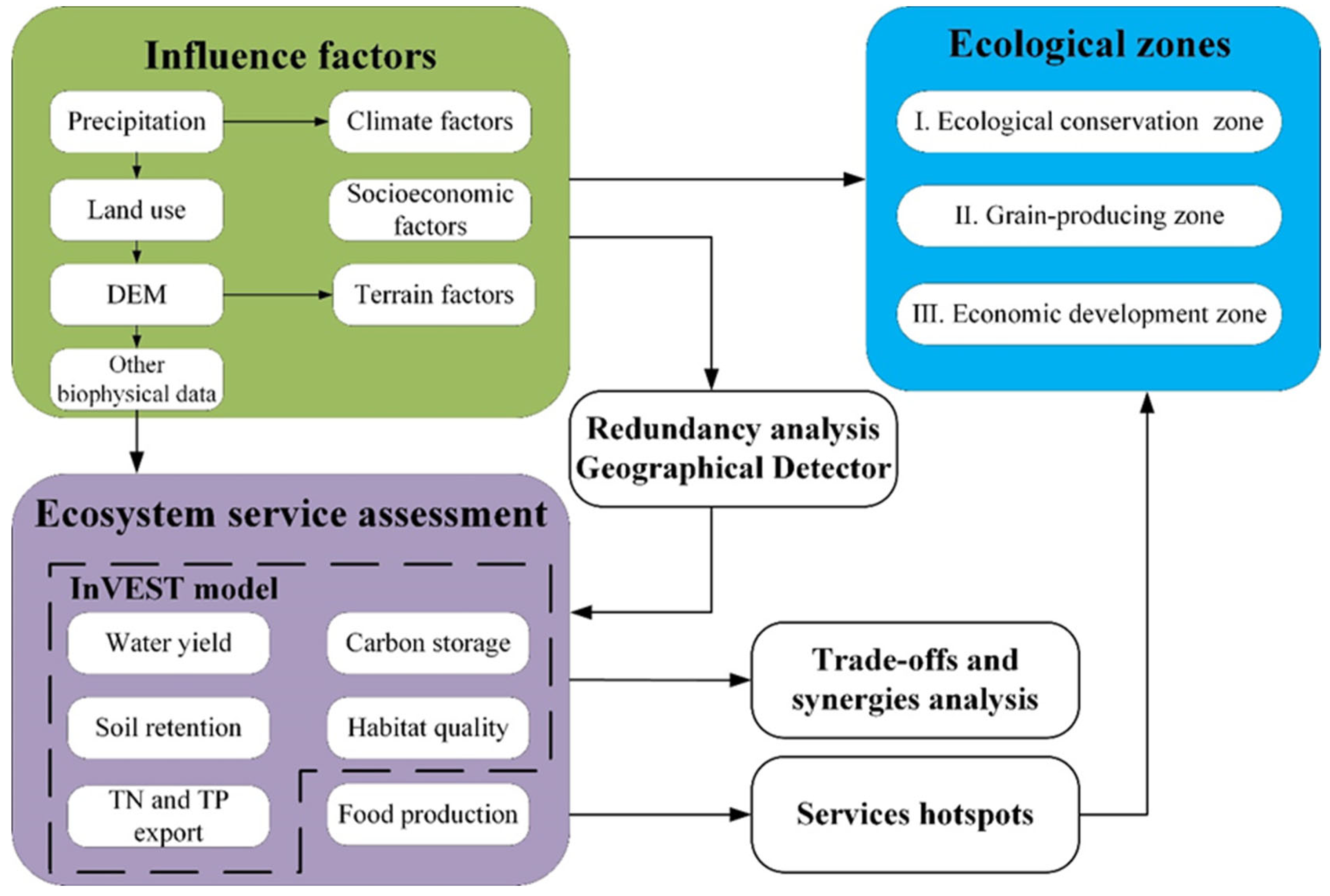

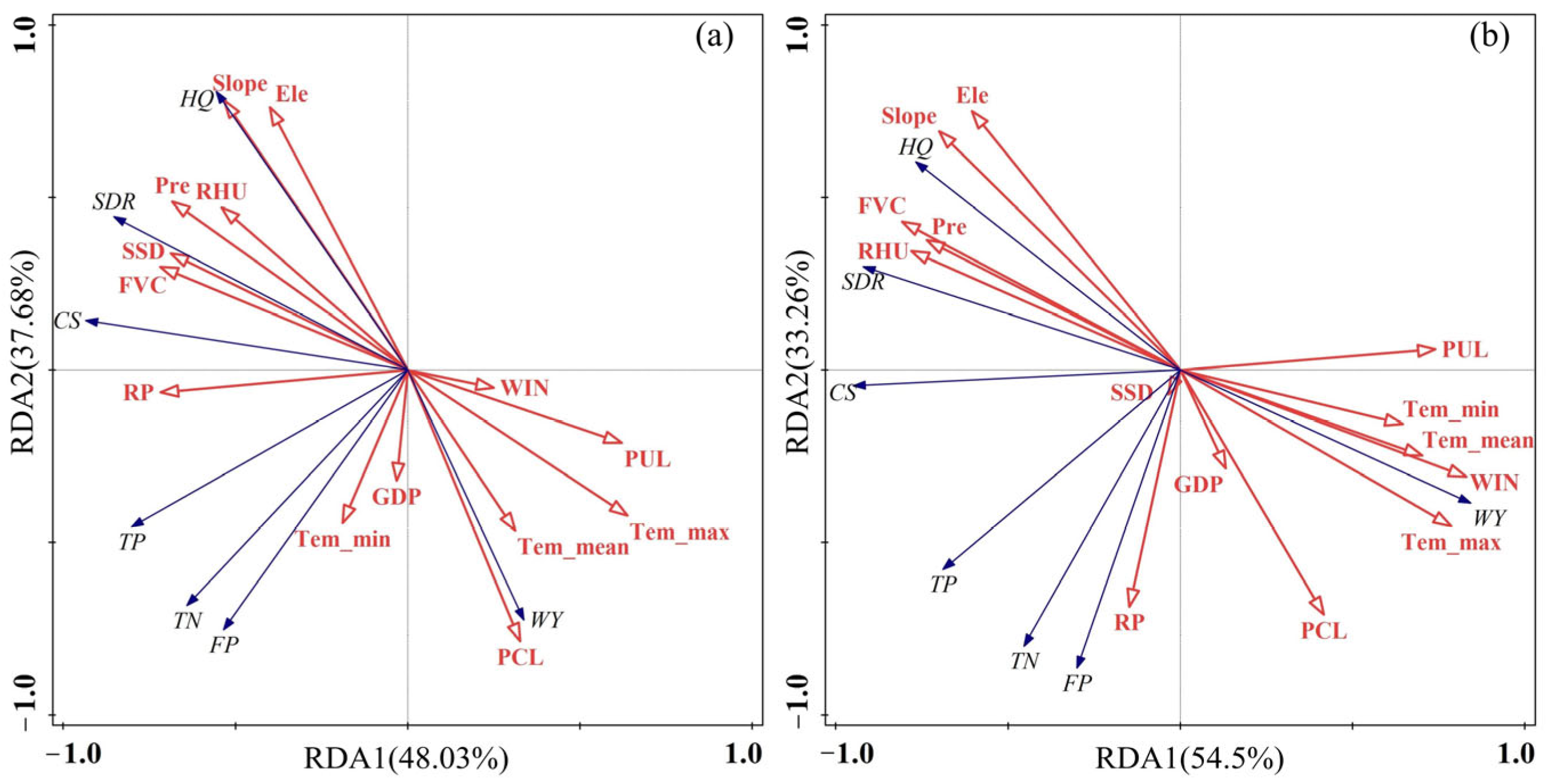

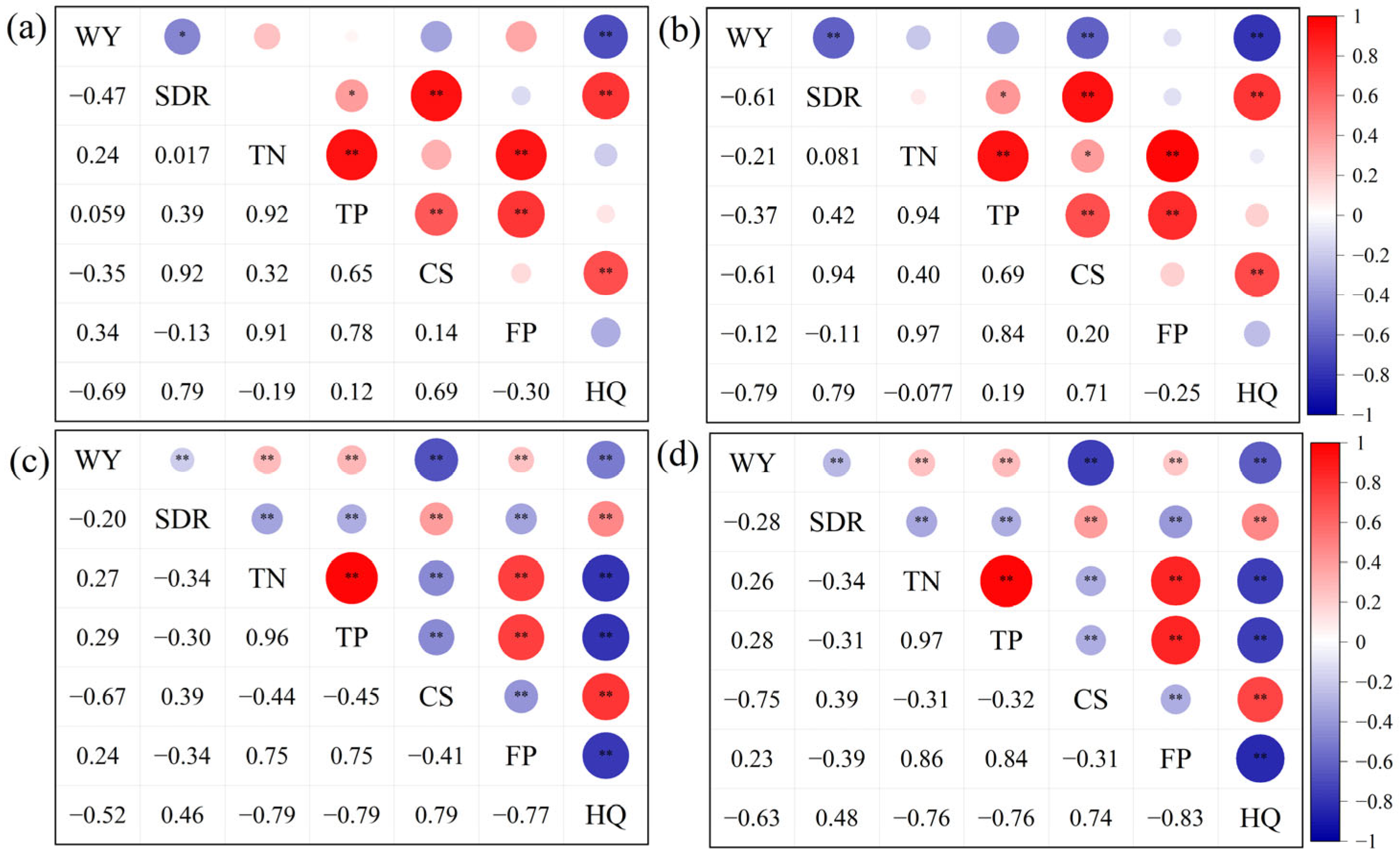

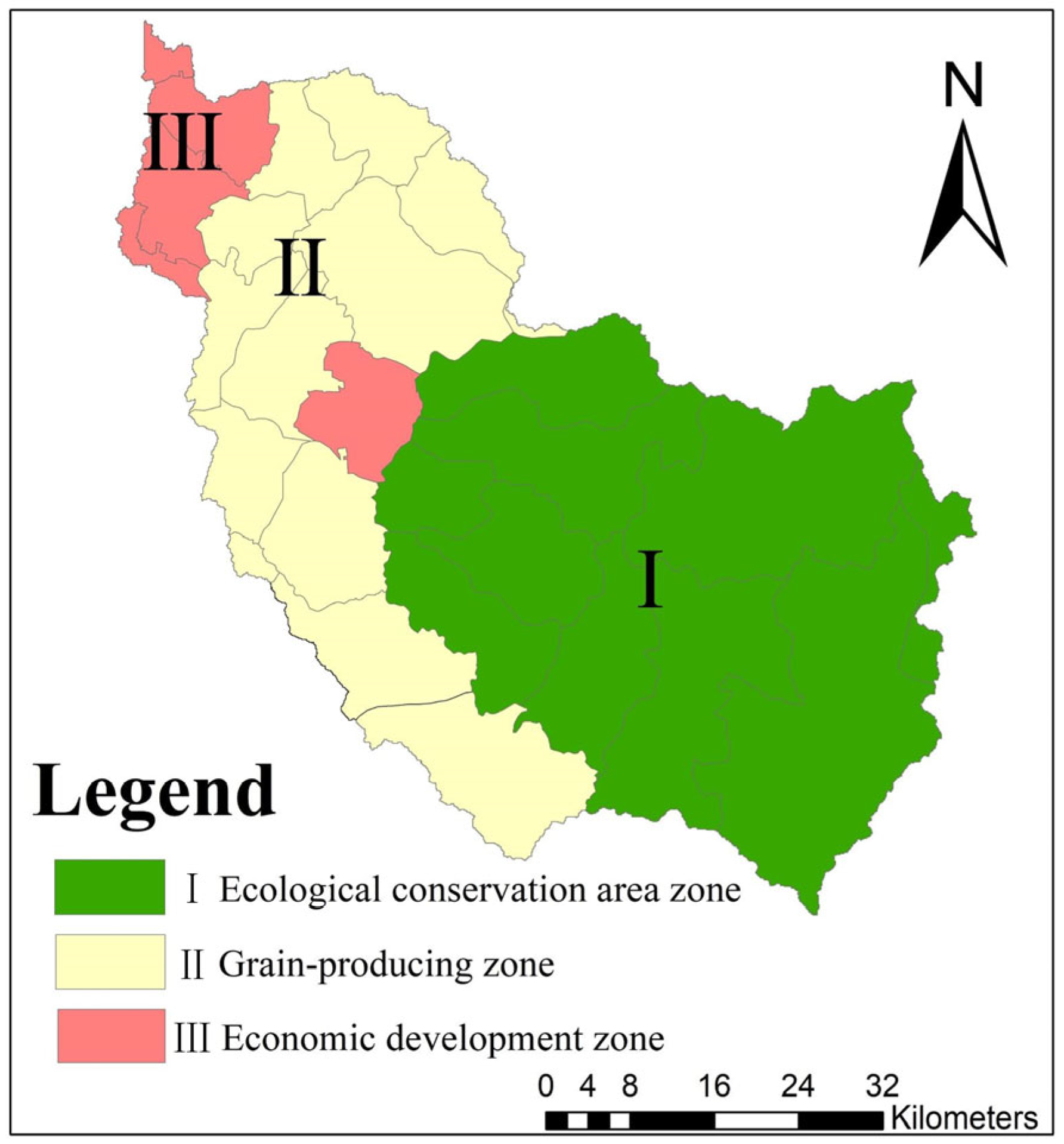
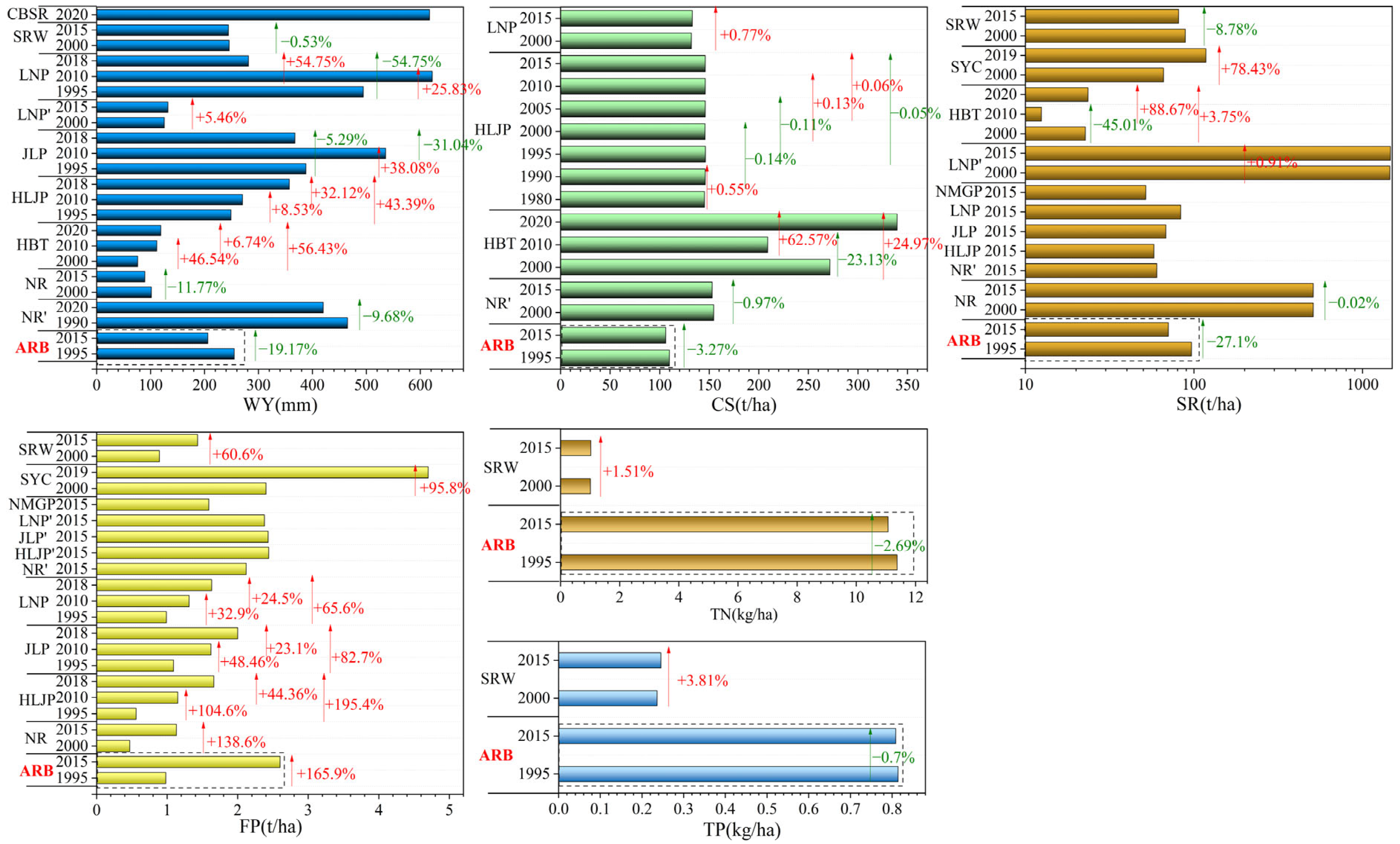
| Data | Sources | Related Model and Factors |
|---|---|---|
| Land use type | Resource and Environment Science and Data Center (http://www.resdc.cn) (accessed on 15 May 2023) | WY, SR, TN, TP, CS, HQ, FP, proportion of urban and farmland. |
| Climate factors | China Meteorological Science Data Center (http://data.cma.cn/) (accessed on 6 June 2023) | WY, SR, TN, TP, precipitation, relative humidity, sunshine duration, wind speed, average temperature, maximum and minimum temperatures |
| Digital elevation model (DEM) | Geospatial Data Cloud (http://www.gsclound.cn) (accessed on 7 August 2023) | TN, TP, SR, elevation, slope |
| Normalized difference vegetation index (NDVI) | United States Geological Survey (USGS) (https://earthexplorer.usgs.gov/) (accessed on 10 September 2023) | FP, FVC |
| GDP, rural population (RP), and food production | Harbin Yearbooks (http://www.harbin.gov.cn/) (accessed on 15 September 2023) | GDP, RP, FP |
| Administrative unit | Standard map service (Ministry of Natural Resources of the People’s Republic of China) | -- |
| Other parameters | The literature and the InVEST user’s guide (https://naturalcapitalproject.stanford.edu/software/invest) (12 December 2022) | WY, SR, CS, HQ, TN, TP |
| Year | Land Use Type | WY (108 m3) | SR (t/ha) | TN (kg/ha) | TP (kg/ha) | CS (t/ha) | FP (t/ha) | HQ |
|---|---|---|---|---|---|---|---|---|
| 1995 | Farmland | 4.61 | 17.77 | 23.17 | 1.42 | 92.60 | 2.05 | 0.00 |
| Forest | 3.36 | 190.49 | 0.35 | 0.24 | 142.00 | 0.00 | 0.99 | |
| Grassland | 0.10 | 103.60 | 1.60 | 0.19 | 91.88 | 0.00 | 1.00 | |
| Water | 0.00 | 6.25 | 0.08 | 0.00 | 0.00 | 0.00 | 0.99 | |
| Urban land | 0.92 | 10.90 | 2.64 | 0.48 | 4.35 | 0.00 | 0.00 | |
| Useless land | 0.05 | 13.69 | 0.87 | 0.00 | 4.29 | 0.00 | 0.00 | |
| 2015 | Farmland | 3.62 | 12.76 | 23.64 | 1.45 | 92.60 | 5.74 | 0.00 |
| Forest | 2.35 | 142.61 | 0.34 | 0.24 | 142.00 | 0.00 | 0.99 | |
| Grassland | 0.04 | 40.75 | 1.31 | 0.15 | 91.88 | 0.00 | 0.97 | |
| Water | 0.00 | 3.69 | 0.04 | 0.00 | 0.00 | 0.00 | 0.99 | |
| Urban land | 1.12 | 8.31 | 2.77 | 0.50 | 4.35 | 0.00 | 0.00 | |
| Useless land | 0.19 | 10.81 | 1.30 | 0.01 | 4.29 | 0.00 | 0.00 |
| 1995 | 2015 | ||||||
|---|---|---|---|---|---|---|---|
| Grassland | Farmland | Urban Land | Forest | Water | Useless Land | Total | |
| Grassland | 2.27 | 8.94 | 0.32 | 28.67 | 0.20 | 0.62 | 41.02 |
| Farmland | 17.02 | 1453.14 | 100.52 | 80.18 | 10.77 | 28.21 | 1689.85 |
| Urban land | 0.06 | 43.28 | 133.94 | 2.23 | 0.22 | 2.01 | 181.74 |
| Forest | 7.29 | 93.05 | 11.46 | 1466.61 | 8.66 | 17.02 | 1604.09 |
| Water | 0.41 | 0.63 | 0.07 | 0.21 | 12.33 | 0 | 13.64 |
| Useless land | 0 | 2.06 | 1.25 | 0.47 | 5.35 | 2.32 | 11.45 |
| Total | 27.04 | 1601.09 | 247.56 | 1578.37 | 37.54 | 50.19 | 3541.79 |
Disclaimer/Publisher’s Note: The statements, opinions and data contained in all publications are solely those of the individual author(s) and contributor(s) and not of MDPI and/or the editor(s). MDPI and/or the editor(s) disclaim responsibility for any injury to people or property resulting from any ideas, methods, instructions or products referred to in the content. |
© 2024 by the authors. Licensee MDPI, Basel, Switzerland. This article is an open access article distributed under the terms and conditions of the Creative Commons Attribution (CC BY) license (https://creativecommons.org/licenses/by/4.0/).
Share and Cite
Guo, X.; Wang, L.; Fu, Q.; Ma, F. Ecological Function Zoning Framework for Small Watershed Ecosystem Services Based on Multivariate Analysis from a Scale Perspective. Land 2024, 13, 1030. https://doi.org/10.3390/land13071030
Guo X, Wang L, Fu Q, Ma F. Ecological Function Zoning Framework for Small Watershed Ecosystem Services Based on Multivariate Analysis from a Scale Perspective. Land. 2024; 13(7):1030. https://doi.org/10.3390/land13071030
Chicago/Turabian StyleGuo, Xiaomeng, Li Wang, Qiang Fu, and Fang Ma. 2024. "Ecological Function Zoning Framework for Small Watershed Ecosystem Services Based on Multivariate Analysis from a Scale Perspective" Land 13, no. 7: 1030. https://doi.org/10.3390/land13071030






